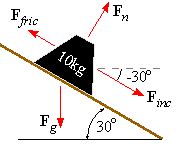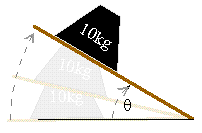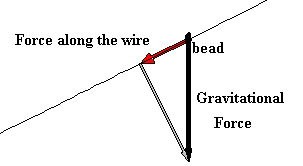Exercises
Sketch the two vectors. Then find the length of each of the
two vectors and their direction. Finally, use (1) to find the
angle between them.
|
|
| | | | |
u =
á 5,12
ñ , v =
á 5,0
ñ |
|
| |
u =
á -1,5
ñ , v =
á2,9
ñ |
| | | |
u =
á 1,11
ñ , v =
á 3,8
ñ |
|
| |
u =
á 6,8
ñ , v =
á8,-6
ñ |
| | | |
u =
á 3,4
ñ , v =
á 6,8
ñ |
|
| |
u =
á 2,2,1
ñ , v =
á6,0,2
ñ |
| | | |
u =
á 3,1,4
ñ, v =
á 2,0,2
ñ |
|
| |
u =
á 0,0,1
ñ , v =
á1,0,0
ñ |
| | | |
u =
á 0,0,1
ñ, v =
á 2,0,2
ñ |
|
|
|
|
Find the value(s) of the parameter k for which the
two vectors are orthogonal.
|
|
| | | | |
u =
á k,7
ñ , v =
á -1,5
ñ |
|
| |
u =
á 3,1,2
ñ , v =
á-2,k,2
ñ |
| | | |
u =
á 0,2,1
ñ, v =
á 6,k,2
ñ |
|
| |
u =
á k,2,k
ñ , v =
ák,-3,1
ñ |
| | | |
u =
á0.2,3k,1
ñ , v =
á 6,9.1,2
ñ |
|
| |
u =
á -0.1,-2.3,7.5
ñ , v =
á 2.3,3.5,k
ñ |
| | | |
u =
á0.2,3k,1
ñ , v =
á 6,9.1,2
ñ |
|
|
|
|
Find the projection of the vector v onto
the vector p. Then show that
is perpendicular to p.
|
|
| |
p =
á 1,7
ñ , v =
á2,11
ñ |
| | | |
p =
á 3,4
ñ , v =
á 7,4
ñ |
|
| |
p =
á 1,2,1
ñ , v =
á2,2,7
ñ |
| | | |
p =
á 3,5,9
ñ, v =
á 2,11,6
ñ |
|
| | | | |
|
|
|
Find the direction cosines and direction angles for the
following vectors.
31. Find a 2-dimensional unit vector u which
forms an angle of 30° with the vector v =
á3,4
ñ .
32. Find a 2-dimensional vector u with length
4 which forms an angle of 135° with the vector v =
á 4,1
ñ .
33. Is there a value of k such that u =
á 3,0,2
ñ is perpendicular to v =
á -2,k,2
ñ ? Can you explain geometrically why v cannot be perpendicular to u for any value of k?
34. Find the projection of the vector v =
á 3,1,4
ñ onto the vector p =
á2,-10,1
ñ . Explain.
35. A frictionless bead of mass 1 kg slides down a wire
which is parallel to the vector v =
á 2,1
ñ .
Find projv( Fg) , which is the part of
the gravitational force in the direction of motion of the bead. (Hint: use -9.8 m/sec2 for the acceleration due to gravity near the earth's
surface).
36. Repeat exercise 35 if v forms an angle of
30° with the horizontal.
37. A 10 kg block is initially at rest on a board with a
coefficient of static friction of ms = 0.2 between them. The board
runs 7 feet horizontally and rises 3 feet vertically.
The force of gravity is Fg =
á0,-98
ñ (i.e., product of the mass and an acceleration of -9.8
m/sec2 ).
The force parallel to the incline is Finc
, which is the
projection of Fg onto the vector <7,3> that is parallel to the board.
The
force normal Fn is perpendicular to Finc
. Specifically, Fn is the negative of
Finally, the force of static friction is the force in the opposite direction of Finc with a magnitude of ms ||Fn|| (that is,
|
Ffric = -ms ||Fn|| |

|
|
Finc
||Finc||
|

|
|
|
What are Finc, Fn, and Ffric?
38. The block in exercise 37 will begin to slide if || Finc|| ³ ms || Fn|| . Does this block begin to slide?
39. Repeat exercises 37 and 38 for the block shown below left:
 |
|
|
 | |
Exercise 39 |
|
|
Exercise 40 |
|
40. Suppose a board with a coefficient of static friction of ms = 0.2 is lifted from horizontal as shown above right.
Use exercise 38 to determine the angle q at which
the block begins to slide down the board? (Note: this is also a method for
measuring ms ).
41. Use the properties of the inner product to show that
|
|| u+v||2 = || u||2 + 2u·v + || v||2 |
|
42. Use the properties of the inner product to show that
|
|| u-v||2 = || u||2 - 2u·v + || v||2 |
|
and then use the result to prove the law of cosines,

43. Substitute the vectors u =
áu1,u2,u3
ñ and v =
áv1,v2,v3
ñ into the following identities to prove that
they are true.
|
|
|
| |
|
| |
( ku) ·v = k( u·v) = u·( kv) |
|
|
| |
|
| |
v·v ³ 0 and v·v = 0 only if v = 0 |
|
|
|
|
44. We call u · v = u1v1+u2v2+u3v3 the standard inner product because it is
possible to define other inner products. Indeed, show that if u =
áu1,u2,u3
ñ and v =
áv1,v2,v3
ñ , then
|
u ◦ v = 3u1v1+4u2v2+5u3v3 |
|
also satisfies the properties in Theorem 2.1.
45. Let v =
á a,b,c
ñ and
let k be a scalar.
- Compute || kv|| .
- Show that the result in (a) reduces to | k| || v|| .
46. Let u and v be vectors.
- Explain why 2u·v £ 2|| u|| || v|| .
- Use (a) and the result in problem 45 to show that
|
|| u+v||2 £ || u||2 + 2|| u|| || v|| + || v||2 |
|
and then explain why this implies the triangle inequality || u+v|| £ ||u|| + ||v|| .
47. What are the angles between a diagonal of a cube and
the edges of the cube it is adjacent to? (i.e., the brown and green edges in the
figure below)
48. Suppose we have a pyramid whose base is a square and
whose sides are equilateral triangles.
What is the angle between an edge of a triangle and an adjacent diagonal
of the base?

